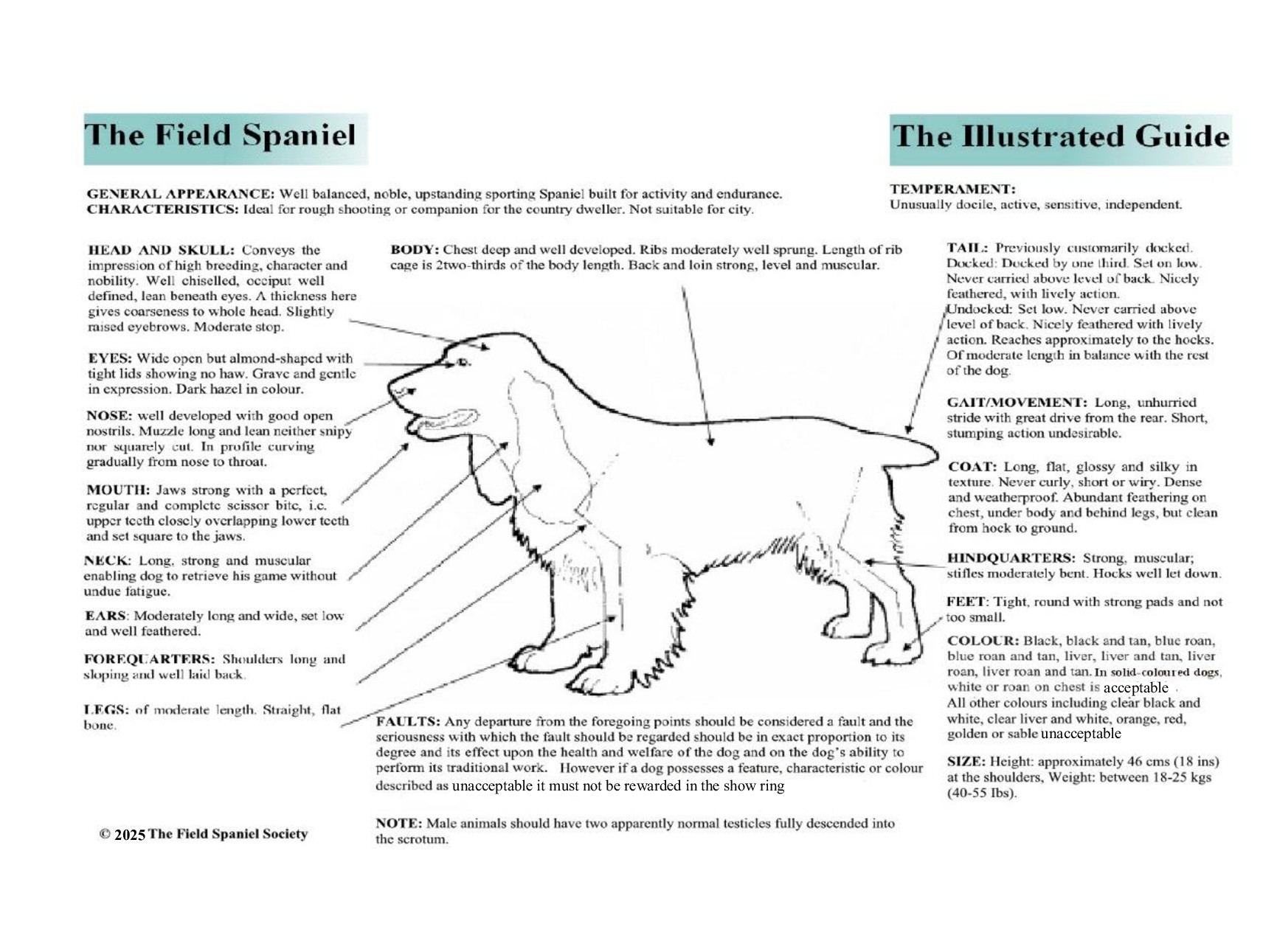Introduction to the Field Spaniel

One of the handsomest and possibly most noble looking of all the Spaniel varieties, the Field Spaniel has had a chequered career since the breed evolved some 150 years ago. At several points over the years the breed has sunk very low in numbers, in the last century three revivals have taken place, the last as late as the 1960s. Numbers have increased considerably in the past ten years, and whereas at one time a Field Spaniel was rarely to be seen at shows, now many open shows put on classes for the breed as well as the majority of championship shows and group shows. As they have become better known, so has the popularity of the Field Spaniel increased, but many of those enquiring for one of the breed to own as a pet and companion have never seen one outside the pages of a book, and so have no idea of the character of the breed or what is involved in the keeping and training of a Field, whilst those seeking a new breed with which to enter the realm of dog shows have little idea of Field Spaniel blood lines, history, or even the type of dog to aim for if they are to have any chance of success in the rings. It is for this reason that the Field Spaniel Society issues this leaflet in a desire to assist would-be owners.
The Field Spaniel is a true country man, active tireless and inquisitive. He is not a dog for those out at work all day who mean to leave him shut indoors alone for hours on end. Be sure he will protest long and loudly and annoy the neighbours, or vent his frustration by ripping the chair seats, chewing slippers, or removing wallpaper as would most dogs.
This is a loving sensitive breed, who likes to be with people and to take part in all that is going on. Nearly all Fields are avid travellers, loving the motor car and often quite content just to sit in one even if not going anywhere. They are not naturally obedient nor are they quick learners, but have to be taught firmly but gently from an early age what they may do and not do. Shouting, beating or any form of violent treatment will get you nowhere with a Field. Stern looks and words and a good shaking when he has been naughty usually works.
Do not imagine that because your dog obeys you one day, he will do so the next. A Field really needs to know his lessons well before he can be entirely trusted to carry out your bidding and even then, such is his sense of fun and desire to make everyone laugh, he will forget all he has been taught and do something quite absurd.
This is one of the larger of the Spaniel breeds, with a weight scale up to 20-25 kilos, and they are great feeders, especially the growing puppy who needs a great deal of the correct type and quality of food at regular hours if he is to grow into a satisfactory specimen. People buying a Field puppy and then feeding it like a Cocker will end up with a weedy, undersized and not very good looking Spaniel. The breed, with it’s highly developed sense of humour, loves to please and be praised, he is wilful and has a healthy streak of naughtiness but a loving affectionate nature. They are hardy dogs, at their best when living a natural outdoor life with plenty of exercise and fresh air.
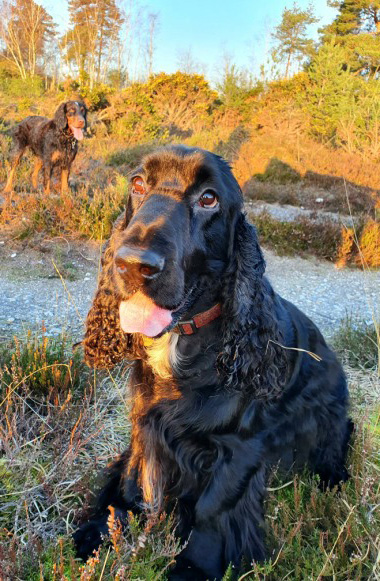
Owing to their normally good coats, Field Spaniels are easy to keep clean and smart, the removal of surplus hair under the ears, and on feet and hocks being all that is required for most specimens, while a daily grooming will keep his jacket shining and healthy.
The Field Spaniel is a true dual purpose spaniel, and those winning on the bench perform equally well in the shooting field. If started young and trained sensibly and slowly, the large majority of the breed take readily to work. An excellent rough shooter’s dog with a keen nose, willingness to face the heaviest cover, excellent in water and utterly tireless. Not natural retrievers they mostly have to be taught this young, but once learned, the lesson is never forgotten, and they have tender mouths and are good on wounded birds.
The Field Spaniel Society manages all the affairs of the breed, promotes the working side, organises seminars on the breed, stages a Championship Show and an Open Show each year, and prepares and publishes a list of judges acceptable to the Society.
Each year the Society publishes for its members a year Book and Newsletter.
Prospective Puppy Owner’s Guide
If in doubt about any issues concerning your puppy contact your puppy’s breeder. Welcome to the world of Field Spaniels and Good Luck with your new puppy.
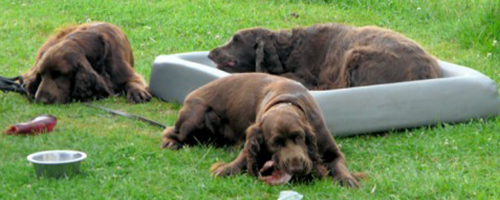
“Many people ask for a Field for a pet and to these I tell the whole truth, for if, after hearing it, they still want a Field, I know it will have a happy and loving home. People must be told how big a Field will grow, what a lot it will eat and how much more exercise it will require than a run in the park or a walk on a lead. They must be told that this is not a breed for people out at work all day, for a Field, shut up alone for hours will quickly get bored and take to chewing the carpets or stripping paper off the walls. Fields can also be very noisy and a Field voice is something to be conjured with and can soon annoy the neighbours. Many Fields are the best escapologists in the world; I had one who could clear a height of six feet from a standing start! They can demolish wire or tunnel underneath it with the speed of light, and unless your garden is securely fenced will be off hunting for hours. People buying a Field must remember that the modern Field was conceived to be an active working gundog, and to a greater extent, it still is. So a Field needs plenty to occupy his mind if it is not to develop bad habits. Above all, Fields are sensitive and affectionate creatures who love the company of humans, and get very lonely if left alone for too long.”
Frequently Asked Questions
I would like to buy a Field Spaniel puppy, how do I do this?
By contacting a reputable breeder. You can access breeder details from the Field Spaniel Society Secretary
I have children can I take them with me to view the puppies?
Yes, you should arrange this with the breeder.
What questions should I ask the breeder?
Ask to see the dam. Ask about hip scores and eye tests.
What will I expect from the breeder when collecting the puppy?
The breeder should provide you with an information pack and this may include:
- Your puppy’s pedigree
- Kennel Club Registration
- Vaccination Certificate
- Microchip Certificate
- 4 weeks Insurance
- Diet sheet
- Field Spaniel Society Code of Ethics
- General information sheet about the breed
- A copy of the breed standard
- Membership form for the Field Spaniel Society
- Puppy packs from some dog food manufacturers
What can I do to make my puppy’s journey home comfortable?
Provide the puppy with a suitable cardboard box or a travel cage, lined with warm bedding.
How should I introduce my puppy to his/her new home?
On arrival home, accompany the puppy whilst he/she explores his/her new surroundings. When you view the puppies leave a piece of dog bedding with the breeder who will ensure that it is scented by the litter. Keep this with the puppy for the first few nights as he/she will be comforted by the smell of his/her siblings. Your puppy may take a day or two to settle and to develop a feeding pattern.
How do I introduce the puppy to my other dog?
As with all pets they should be introduced under close supervision. Never leave a young puppy alone with an older dog. Beware of jealousy from the older dog.
My puppy won’t eat the diet recommended by the breeder, what should I do?
Contact the breeder for advice. Do not start chopping and changing the puppy’s diet. Some Field Spaniels are notoriously faddy eaters and you could end up with a variety of foods that the puppy may eat vigorously at first and then refuse to eat. When following manufacturer recommendations for feeding be aware that they are only recommendations and your puppy’s requirements may vary.
I never seem to be able to feed my puppy enough, why is he/she always hungry?
Over feeding is as bad as underfeeding therefore check with the breeder that you are following a reasonable feeding regime. Check the puppy for worms. Your puppy will have been wormed and you should follow the worming program given to you by the breeder. Or ask your vet for advice. Never over feed a Field Spaniel puppy; too much weight particularly across the shoulders on a young puppy can cause the front legs to bow and push the elbows out. Always ensure the puppy has access to water especially if using a complete diet.
My puppy wants to run about and play all day, is this OK?
Field Spaniel puppies like all puppies should not be over exercised. You must decide when your puppy will rest, don’t allow him/her to run until he/she drops. Do not allow your puppy to climb up or down stairs and discourage him/her from jumping on or off Obstacles as these could push elbows out and or bow his/her front.
My puppy looks as though he is flapping his front feet, why is this?
This is known as ‘ being down on the pasterns or collapsing front’. It is a temporary condition usually occurring during teething around 3 to 3 ½ months and can persist until teething is complete. Give plenty of rest and follow advice from previous question. Walking the puppy over gravel sometimes helps, this is uncomfortable on the puppy’s feet causing him/her to tighten the feet up and this in turn can tighten the muscle controlling the pastern. Speak to the puppy’s breeder for further information and advice on this condition.
Additional Information
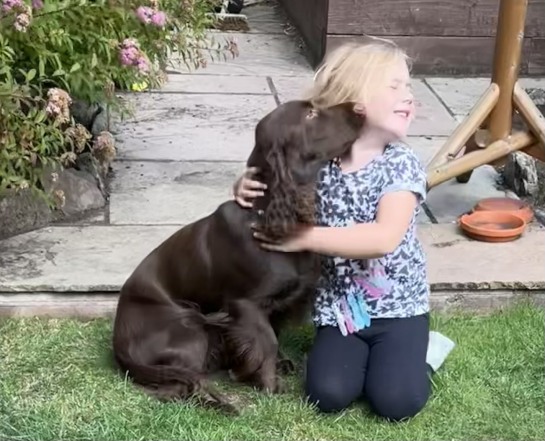 Don’t play tug of war with a young puppy. Tugging hard could cause problems with his/her bite.
Don’t play tug of war with a young puppy. Tugging hard could cause problems with his/her bite.
Grooming your puppy regularly gives you an opportunity to check him/her for any lumps, bumps or health problems. Check eyes, ears and feet for grass seeds.
Keep the hair on the inside of the ear trimmed out to allow air to flow to the ear, this helps to prevent smelly ears. Trim the hair out from under the pads as this stops collection of mud or snow under pads and allows puppy to walk on the pads and not on hair. Keep toe nails short as this helps keep neat round feet.
Bath using a shampoo designed for a canine coat. A dog’s PH is different to ours.
Using clippers on a Field spaniel coat can cause the coat to become curly and this is not desired.
Spayed Field spaniel bitches can develop a fluffy/ duffle type coat texture. She may also become slightly incontinent when older. Speak to your vet for more information on the latter.
Castrated dogs may develop a fluffy/ duffle type coat texture.
Ask your breeder and or vet about vaccinations prior to collection. Your puppy may already have had the first part of the initial vaccinations.
Socialisation of Field puppies, as with all puppies, begins in the nest with his/her dam and siblings. The breeder may already have introduced your puppy to normal household sounds and sights.
Once the vaccinations are complete, ask the vet when you can begin to walk the puppy and begin his/her training. Field spaniels are intelligent dogs but can be stubborn and require gentle, consistent training, once a week at training classes and ten minutes each day is usually sufficient.
A Guide to Working the Field Spaniel
The Field Spaniel as a minor breed at times gets confused with and thought of as a large Working Cocker Spaniel or a Springer Spaniel, they are neither they are very much a separate breed. They are known for been calmer than both the Cocker or Springer Spaniel.
They are still very much a dual purpose spaniel, which means you can work them through the week and show them at the weekend during the shooting season.
Training your Field Spaniel starts as with all dogs at an early age with basic obedience: sit, stay, heel, fetch and of course recall find a local training club as not only does this help you with basic training it also helps socialise puppy which is also very important. Keep the training sessions short so the young dog doesn’t get bored and always end on with a favourite activity so that both you and the dog are happy and he will see his training as fun you can also start to introduce the Gundog whistle.
Gundog training at around 6 months old and around then look around for a local Gundog club that may hold training sessions through parts of the spring and summer months.

Training a Field can seem slow compared to training some of the other working spaniel’s, they can be stubborn and wilful but they are also very willing to please. They do not react well to been shouted at and any form of harsh treatment, all that does is make them withdraw into themselves, so you need patience and sometimes a little more patience and a good sense of humour but once trained you won’t have a better companion to take with you on a shoot.
The Field Spaniel can and does both air and ground scent equally well and many gundog people who don’t know the breed will think they are not working because their heads are up however this is far from the case at times they seem to find more birds when air scenting. They will face and push through the thickest cover and love to retrieve from water.
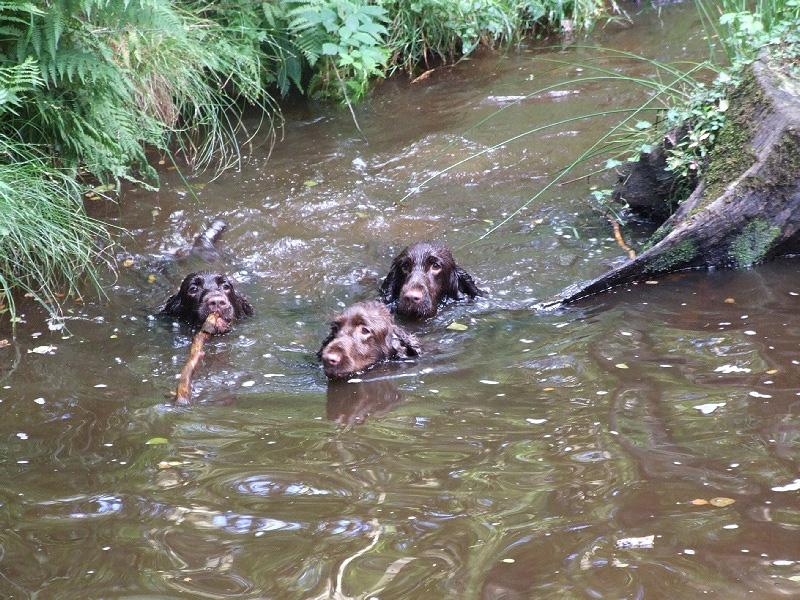
It’s true that on the whole they do have a slower working pace than the Working Cockers and Springer Spaniels they don’t charge about, they are methodical in their work but they find and flush birds the others miss with their faster pace.
Field Spaniels also take part in Working Tests and Field Trials for Minority Spaniels (Welsh Springer Spaniels, Clumber Spaniels, Sussex Spaniels and Field Spaniels)
Working Tests are held by minority breed clubs in different locations around Britain, they are set up to show your dogs ability if he were working, except there is no game as they are held in late spring and through to the early autumn. Instead of game, canvas dummies or dummies covered in rabbit skin are used and only blank shots from a starting pistol. However your dog will still be expected to listen to commands, hunt and retrieve as if on a real shoot under the watchful eye of a judge. They are good for the young dog waiting to go on his first shoot and the older dogs to keep them keen. The people who run them and take part are always happy to help and offer advice.
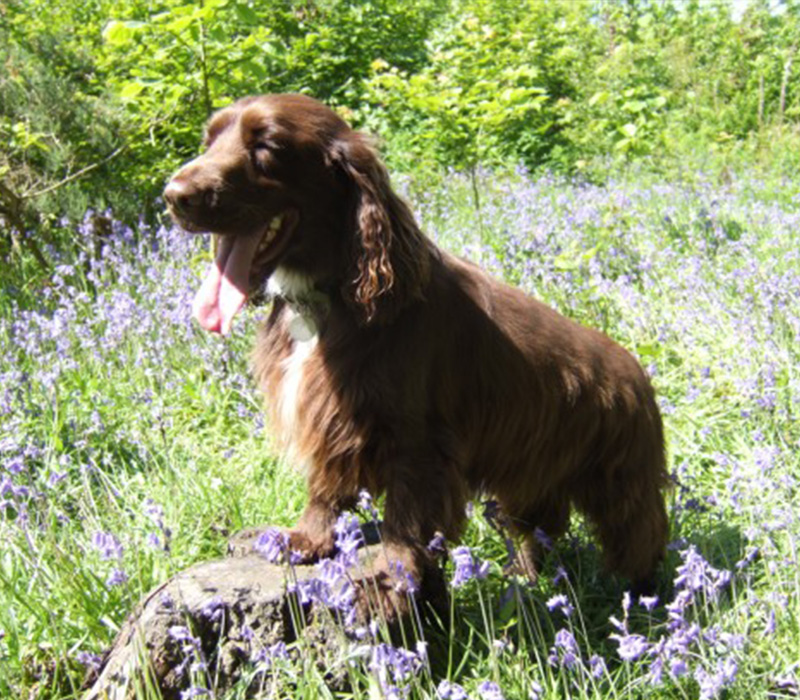
The Royal Kennel Club Breed Standard
A Breed Standard is the guideline which describes the ideal characteristics, temperament and appearance including the correct colour of a breed and ensures that the breed is fit for function. Absolute soundness is essential. Breeders and judges should at all times be careful to avoid obvious conditions or exaggerations which would be detrimental in any way to the health, welfare or soundness of this breed. From time to time certain conditions or exaggerations may be considered to have the potential to affect dogs in some breeds adversely, and judges and breeders are requested to refer to the Breed Watch section of the Kennel Club website here https://www.thekennelclub.org.uk/services/public/breed/watch for details of any such current issues. If a feature or quality is desirable it should only be present in the right measure. However if a dog possesses a feature, characteristic or colour described as unacceptable it must not be rewarded in the show ring.
General Appearance
A well balanced, noble, upstanding sporting Spaniel built for activity and endurance.
Characteristics
Ideal for rough shooting or as a companion for the country dweller. Not suitable for the city.
Temperament
Unusually docile, active, sensitive,independent.
Head and Skull
Conveys the impression of high breeding, character and nobility. Well chiselled, occiput well defined, lean beneath the eyes. A thickness here gives coarseness to the whole head. Slightly raised eyebrows. Moderate stop. Nose well developed with good open nostrils. Muzzle long and lean neither snipy nor squarely cut. In profile curving gradually from nose to throat.
Eyes
Wide open but almond-shaped with tight lids showing no haw. Grave and gentle in expression. Dark hazel in colour.
Ears
Moderately long and wide, set low and well feathered.
Mouth
Jaws strong with a perfect, regular and complete scissor bite. i.e. upper teeth closely overlapping lower teeth and set square to the jaws.
Neck
Long, strong and muscular enabling dog to retrieve his game without undue fatigue.
Forequarters
Shoulders long and sloping and well laid back. Legs of moderate length. Straight, flat bone.
Body
Chest deep and well developed. Ribs moderately well sprung. Length of ribcage is two-thirds of the body length. Back and loin strong, level and muscular.
Hindquarters
Strong, muscular; stifles moderately bent. Hocks well let down.
Feet
Tight, round with strong pads and not too small.
Tail
Previously, customarily docked. Docked:. Set on low. Never carried above the level of the back. Nicely feathered, with lively action. Previously,customarily docked by one third. Undocked: Set low. Never carried above the level of the back. Nicely feathered with lively action. Reaches approximately to the hocks. Of moderate length in balance with the rest of the dog.
Gait/Movement
Long, unhurried stride with great drive from the rear. Short stumping action undesirable.
Coat
Long, flat, glossy and silky in texture. Never curly, short or wiry. Dense and weatherproof. Abundant feathering on chest, under body and behind legs, but clean from hock to ground.
Colour
Black, black and tan, blue roan, blue roan and tan, liver, liver and tan, liver roan, liver roan and tan. In solid-coloured dogs, white or roan on chest is acceptable. All other colours, including clear black and white, clear liver and white, orange, red, golden or sable unacceptable. (See introductory paragraph).
Size
Height: approximately 46cms (18ins) at the shoulders. Weight between 18-25 kgs (40-55 Lbs).
Faults
Any departure from the foregoing points should be considered a fault and the seriousness with which the fault should be regarded should be in exact proportion to its degree. and its effect upon the health and welfare of the dog and on the dog’s ability to perform its traditional work.
Note: Male animals should have two apparently normal testicles fully descended into the scrotum.
Published with kind permission from The Kennel Club © The Kennel Club
